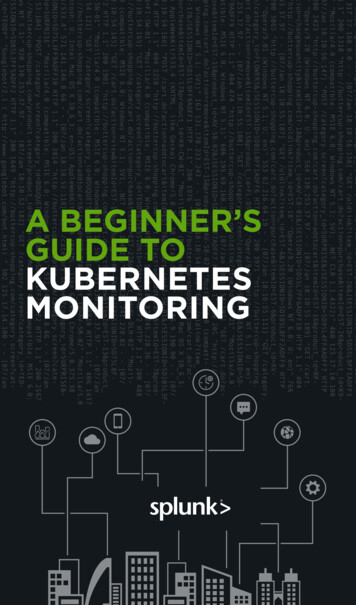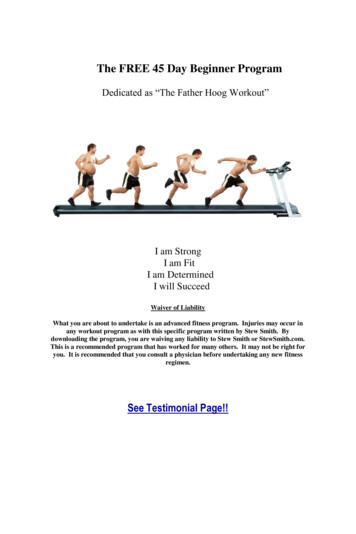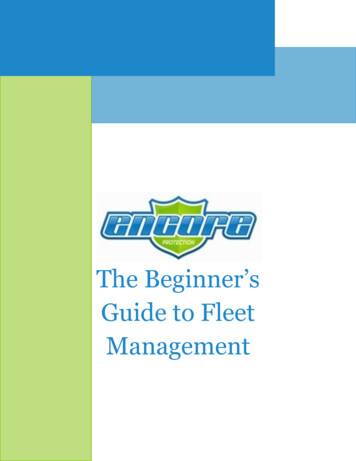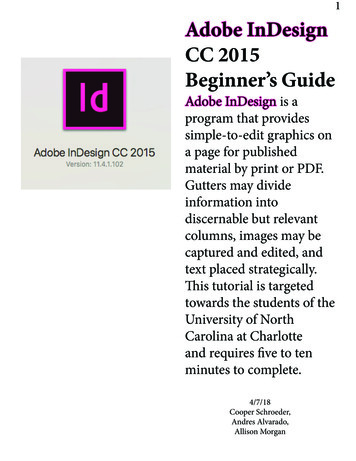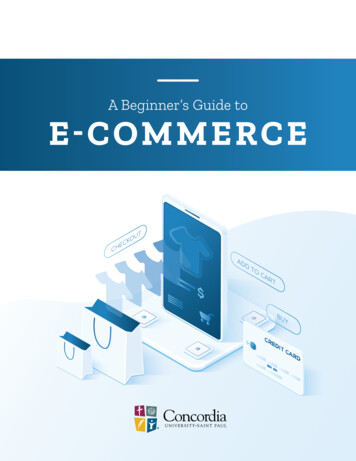
Transcription
A Beginner’s Guide toE-COMMERCE
Table of ContentsWhat is E-commerce?. . . . . . . . . . . . . . . . . . . . . . . . . . . . . . . . . . . 4Evolution of E-commerce. . . . . . . . . . . . . . . . . . . . . . . . . . . . . . . . 5Precursors to E-commerce. . . . . . . . . . . . . . . . . . . . . . . . . . . . . . . . . . . . . . . . 5Amazon and eBay Enter the Conversation . . . . . . . . . . . . . . . . . . . . . . . . . . 6The Modern E-commerce Landscape. . . . . . . . . . . . . . . . . . . . . . . . . . . . . . . 6Business-to-Consumer (B2C) E-commerce . . . . . . . . . . . . . . . . . . . . . . . . . . . 7Business-to-Business (B2B) E-commerce. . . . . . . . . . . . . . . . . . . . . . . . . . . . . 7Consumer-to-Business (C2B) E-commerce . . . . . . . . . . . . . . . . . . . . . . . . . . 8Consumer-to-Consumer (C2C) E-commerce. . . . . . . . . . . . . . . . . . . . . . . . . 8Government E-commerce. . . . . . . . . . . . . . . . . . . . . . . . . . . . . . . . . . . . . . . . . 9Why E-commerce?. . . . . . . . . . . . . . . . . . . . . . . . . . . . . . . . . . . . . 10Trends in E-commerce. . . . . . . . . . . . . . . . . . . . . . . . . . . . . . . . . . 11Influencer Marketing. . . . . . . . . . . . . . . . . . . . . . . . . . . . . . . . . . . . . . . . . . . . . 11One-click Purchasing. . . . . . . . . . . . . . . . . . . . . . . . . . . . . . . . . . . . . . . . . . . . . 11Social Shopping. . . . . . . . . . . . . . . . . . . . . . . . . . . . . . . . . . . . . . . . . . . . . . . . . 12Subscription Services . . . . . . . . . . . . . . . . . . . . . . . . . . . . . . . . . . . . . . . . . . . . 12The Future of E-commerce. . . . . . . . . . . . . . . . . . . . . . . . . . . . . 13A Beginner’s Guide to E-commerce page 2
Not so long ago, the idea shopping without visiting astore seemed like a futuristic concept. Fast forwardjust a couple of decades, and it is a given. In under oneminute, you can open an app or web browser and getsomething delivered the next day or even sooner. Or youcan reserve your order and pick it up the same day. Thephenomenon of electronic commerce, or e-commerce,appeals to consumers and businesses alike and, as thestatistics demonstrate, it has taken off dramatically.According to the U.S. Census Bureau, e-commercesales in 2018 accounted for 9.7% of total sales.That’s more than six times the figure 15 years prior,when, in 2003, e-commerce sales represented just1.6% of total sales.E-commerce doesn’t appear to be slowing down.In 2017, market research company Forresterpredicted that e-commerce would comprise 17% ofretail sales in the United States by 2022. The samereport predicted 13% year-over-year growth foronline sales. A separate forecast from the NationalRetail Federation estimated the annual online retailgrowth at 10-12%.Those figures are impressive and help pute-commerce into perspective, but there’s a lotmore that you need to know. This guide can helpyou learn about the benefits of online storefronts,opportunities to market to prospective customersonline, and grow your general business knowledge.The upcoming sections explore themes likethe benefits of e-commerce, specific trends ine-commerce, and the future of e-commerce.Follow along to develop a basic understandingof e-commerce.A Beginner’s Guide to E-commerce page 3
What is E-commerce?The easiest way to define e-commerce is electronic transactions that take place online. If buying or sellingis involved of products or services online, then it qualifies as e-commerce. As a result, all of the followingexamples are considered e-commerce: Purchasing and downloading digital music files online. Buying a physical book online and having it delivered to your home. Reserving products at a home improvement store’s website and then picking them up in-person.Each of those scenarios uses an online platform in some part of the transaction’s life cycle. It could becompletely online, in the case of a digital music purchase, or simply using the internet to find what youneed at a local store. Note that all of the previous examples are business-to-consumer e-commerce. Asyou’ll discover in the section on the types of e-commerce, online transactions can be involved in otherareas, like when businesses sell products and services to other businesses.If you’re wondering how some sources vary in their definitions for e-commerce, that typically revolvesaround how much of the transaction needs to take place online. Some say that if terms of the sale don’ttake place online (e.g., you see a product online and purchase it in-person locally), or that if paymentdoesn’t take place online, then it’s not e-commerce.You don’t need to worry about those intricacies, but if you’re interested in seeing a comprehensivedefinition, here’s how the U.S. Census Bureau approached the term:E-commerce sales are sales of goods and services where the buyerplaces an order, or the price and terms of the sale are negotiatedover an Internet, mobile device (M-commerce), extranet, ElectronicData Interchange (EDI) network, electronic mail, or other comparableonline system. Payment may or may not be made online.A Beginner’s Guide to E-commerce page 4
Evolution of E-commerceE-commerce may command a large share of the current retail market, but that’s a relatively recentdevelopment. Brick and mortar businesses dominated until companies like Amazon and eBay utilizedonline technologies to reach customers. Now, “click and mortar” businesses regularly blend physical storesand online platforms to sell products and services.How did the present generation of internet-savvy businesses get to where it is today? Here are some ofthe major events and trends in the history of e-commerce.PRECU RS ORS TO E -C OMME RC ESeveral technological advancements led to modern-day e-commerce.You can go as far back to the 1960s, which marked electronic transactions onprimitive computer networks. Instead of computers processing purchase ordersand invoices on paper, they could communicate information electronicallythrough a concept known as the Electronic Data Interchange (EDI). Meanwhile,the military created ARPAnet, allowing the transfer of important information if anuclear attack occurred. It’s hard to imagine, but the EDI and ARPAnet actuallyserved as the foundation to e-commerce as we know it.The next set of events took place in the 1980s. In the early part of thedecade, research computers at universities could send emails and sharedocuments. In 1984, CompuServe added a service allowing home computerusers to browse the Electronic Mall, which featured products from more than100 online retailers. Product demos and full-color photos were also available toconsumers, which was innovative for the time. The Electronic Mall wasn’t a bigsuccess, but it was one of the earliest examples of online retail.Until 1991, there was a ban prohibiting commercial businesses from operatingover the internet. When the National Science Foundation lifted its ban at thattime, e-commerce became possible. The only thing left to address was security,and that was ironed out in 1994. Secure Socket Layer (SSL) was integratedonto the internet browser Netscape 1.0, enabling secure financial transactionsto take place online.It didn’t take long for them to start. On August 11, 1994, a consumer purchaseda Sting album online. The consumer reportedly used a secret code to sendhis credit card number to a team of young cyberspace entrepreneurs whodeveloped a secure online marketplace. This transaction made headlines andpaved the way for modern-day e-commerce.A Beginner’s Guide to E-commerce page 5
A M AZON A N D EB AY E NT E R T HE CONVE RSAT IONThere’s no question that Amazon and eBay did more for the evolution ofe-commerce than any other companies. They began in the mid-1990s, andwithin just a decade, both businesses had amassed tens of millions of users.Amazon began by selling books to shoppers. With virtually no competition,Jeff Bezos, Amazon’s founder and CEO, was able to expand from books intoproduct categories like music, clothing, and now, virtually anything you canthink of. In 2005, 10 years after Amazon sold its first book, the company earned 359 million in revenue, according to International Business Times. In the firstquarter of 2019 alone, Amazon reported 59.7 billion in revenue.eBay started the same year Bezos launched Amazon. eBay began asAuctionWeb and offered users the ability to bid on other people’s used items.The auction platform appealed to a wide range of consumers who could nowfind deals on a wide range of products. By 2007, eBay amassed more than220 million users and earned 52.5 billion.TH E M OD ERN E- CO MME RC E LANDSCAPEThere’s an obvious overlap to what Amazon and eBay did, and then lookingat what e-commerce is today. Thanks to the two e-commerce giants, onlinetransactions are now a regular part of how companies do business.It’s so foundational that it’s now unusual for a retailer to be 100% brick andmortar. Today, consumers expect companies to offer their products online insome capacity. From having an online catalog to, for larger retailers, the abilityto reserve products online for in-store pickup, the click and mortar approach tobusiness is now standard. That trend refers to how businesses have online andoffline operations, to accommodate customers on either end of the spectrum.That way, people can enjoy the convenience of either option. Consumers canshop from the comfort of their own home late at night or head to a store to seedifferent products options in person.There’s a lot more on what the modern e-commerce landscape looks like, and the rest of the guideinvestigates that further. Take a look at the upcoming sections to get filled in on what the evolution ofe-commerce has led to. The next topic, on the types of e-commerce, exemplifies how widespread onlinetransactions have become in all kinds of business models.A Beginner’s Guide to E-commerce page 6
Types of E-commerceThe revolutionary e-commerce business models of Amazon and eBay affected more thanonline retail. It led to companies across any business model spectrum recognizing howe-commerce could enhance business.The result is that there are now several types of e-commerce. Here’s a quick look at each one.B U SI N E S S -TO- CON S U M ER ( B2C ) E -COMME RCEB2C e-commerce is probably what comes to mind when you first hear the term “e-commerce.” It basicallyrefers to products or services marketed from a business to individual people.Many popular examples illustrate B2Ce-commerce. For instance, if you head toAmazon or Walmart’s website to purchasesomething, that’s B2C e-commerce in action.The same is true for most things that youpurchase online for personal use. If it’s soldby a company, then it fits in with this type ofe-commerce.B2C e-commerce is what started it all. Fromthe Electronic Mall to the first official onlinepurchase in the form of a Sting album, thoseearly examples are rooted in B2C e-commerce.A Beginner’s Guide to E-commerce page 7
B U SI N E S S -TO- B U S IN ES S ( B 2B) E -C OMME RC ENot all businesses market to individual consumers. Some sell products and services to other companies.When that takes place online, you have B2B e-commerce.One example of B2B e-commerce is web development. Every company practically needs a website, duein part to, ironically, concepts like e-commerce. If a company wants to have a virtual storefront, they’ll needto build a website. That business might look around for a web development company that has experiencein e-commerce, and if they find one online that they hire, that’s B2B e-commerce in action. The webdevelopment company provided a product for another business.The same basic idea occurs in other industries. Your typical local business may purchase office equipmentonline from a retailer like Xerox. If that local business needs vehicles to perform core functions, they mightorder parts, such as tires, online from a company like Goodyear. Xerox and Goodyear, in those examples,are taking part in B2B e-commerce. Of course, those two companies are also involved in B2C e-commerce.C O NS U MER-TO- B U S IN ES S ( C2B) E -COMME RCESometimes, the traditional roles are reversed. You might be used to businesses selling products andservices to consumers online (B2C e-commerce), but sometimes individual customers can sell productsand services to businesses.One example is with paid reviews. If a consumer owns his or her own blog, that person may approach arelevant business with an opportunity to place a product or service on the blog. The business pays theindividual for the blog post, video, or podcast, and benefits from the marketing opportunity. Because all ofthat happens online, it qualifies as C2B e-commerce.Another good example of C2B e-commerce reflects a popular trend for individuals to earn or supplementtheir living. Platforms have emerged that allow freelancers to market their skills to clients. On those websites,freelance photographers, writers, developers, and more will secure assignments from businesses. It’s C2Be-commerce because individuals are selling products and services to businesses online.A Beginner’s Guide to E-commerce page 8
C O NS U MER-TO- CON S U M ER (C 2C) E -C OMME RC EIf consumers can sell products and services to businesses online in C2B e-commerce, it’s only a small stepto consumers selling to other consumers.An easy way to illustrate C2C e-commerce is through the freelance platforms in the previous type ofe-commerce. Instead of freelancers selling their products and services to businesses, freelancers in C2Ce-commerce engage in work with other consumers. Think of a consumer who wants a professionallydesigned graduation party announcement done or a family website built. Neither party is anestablished business.Other examples are even more straightforward. Imagine a married couple who wants pictures takenfrom someone they find online who has a passion for photography. Since the provider doesn’t have anactual photography business, that type of relationship and transaction would constitute C2C e-commerce.Another common scenario is when people sell items online, at websites like eBay and Craigslist, to otherpeople. Transactions take place online and no party is an established business. Thus, it’s C2C e-commercein action.G OV E R N M EN T E- COM M ERCEIt’s also possible for businesses or consumers to engage in e-commerce transactions.One example is found in consumer-to-government (C2G) e-commerce, when individuals pay thegovernment online for taxes or university tuition. Another type of government e-commerce is whenbusinesses perform services for governmental organizations. The strategic information technologycompany Synergetics has a client list that includes the National Institutes of Health, the Department ofVeterans Affairs, the Department of Defense, and the Department of Agriculture. That model of business isreferred to as business-to-government (B2G) e-commerce.Other opportunities may be possible in the future, too. “The 2018 National Defense Authorization Actcalled for the creation of an Amazon.com-like portal for federal buyers, which put the General ServicesAdministration on a tight schedule to develop and test such a platform,” according to Federal ComputerWeek. “GSA plans an initial pilot of the system in late 2019 with a limited number of agency participants.”A Beginner’s Guide to E-commerce page 9
Why E-commerce?Compare to traditional retail, e-commerce has benefits that can take a business to the next level. A lot ofpeople simply assume that businesses should integrate e-commerce capabilities into their business plan,but it’s important to understand why that’s often the case.The most obvious benefit to e-commerce is so basic that you may think it doesn’t need to be addressed:consumers can shop online. The ability for people to purchase products and services online instead ofin person is, to put it plainly, huge. All of a sudden, geography doesn’t matter as much. An e-commercewebsite means that a business doesn’t have to have a prime location in the city or even a traditional storeat all.Customers shopping online instead of in person leads to other benefits for businesses. Instead ofmarketing to an audience locally through more traditional advertising methods, online marketing is thefocus in e-commerce. Concepts like search engine optimization (SEO), pay-per-click advertisements,and social media help level the playing field a bit. Costs are typically lower in online marketing than thetraditional marketing methods requiredto succeed in traditional retail. It’s alsocheaper to run an e-commerce storeonce you consider personnel costsversus what it takes to run an automatedwebsite. Having no real estate costs ine-commerce is another bonus.A Beginner’s Guide to E-commerce page 10
Trends in E-commerceWhat are some notable concepts that are impacting the world of e-commerce. You could find dozensupon dozens of examples, but here are just a few trends that demonstrate what businesses can do withonline storefronts.I N FLU E NCER M A RKETIN GInfluencer marketing is a social media marketing strategy that uses influential people to draw attention tothe product or brand.Think of it as a new spin on having a spokesperson. However, influencer marketing is often moreshort-term in nature. In influencer marketing, a person is approached online by a business looking tocapitalize on the influencer’s considerable social media following. If that following is closely linked to thebusiness’s niche, then it makes for a good partnership. The influencer is paid for marketing a product orservice. One example might be a fashion influencer being paid by an up-an-coming designer to showcasea new line of accessories.Those types of relationships can exist in nearly any type of business. Across platforms like Instagram,Twitter, and even YouTube, influencer marketing can help businesses quickly get in front of a specificaudience that they’re trying to target.ON E - C LI CK PU RCH AS IN GOne-click purchasing is exactly what it sounds like. E-commerce stores can simplify the shoppingprocess by enabling users to complete their entire purchase without having to go through several stepsto checkout.Both sides benefit from one-click purchasing. Customers save time by avoiding the need to select saved ordefault options, like shipping speed and payment method. Businesses can enhance their profits becauseone-click purchasing increases impulse buys. Additionally, this concept caters to mobile users who need tomake a purchase when they don’t have the time to spend with unnecessary checkout steps. If the systemis as easy as possible to complete, consumers are more likely to make purchases at the site.A Beginner’s Guide to E-commerce page 11
S OC I A L SH OPPIN GSocial shopping is another e-commerce trend that builds off the idea that making things easier forconsumers to shop will result in increased profits. In social shopping, people viewing products on socialmedia networks receive a direct link where they can make a purchase.This feature has been integrated on Instagram and Pinterest. When people are searching for somethinglike art project ideas for children or a way to decorate their home, they may come across a great activity ora set of matching pillows and blanket. In each scenario, viewers are finding a s
B2C e-commerce is probably what comes to mind when you first hear the term “e-commerce.” It basically refers to products or services marketed from a business to individual people. Many popular examples illustrate B2C e-commerce. For instance, if you head to Amazon or Walmart’s websit

